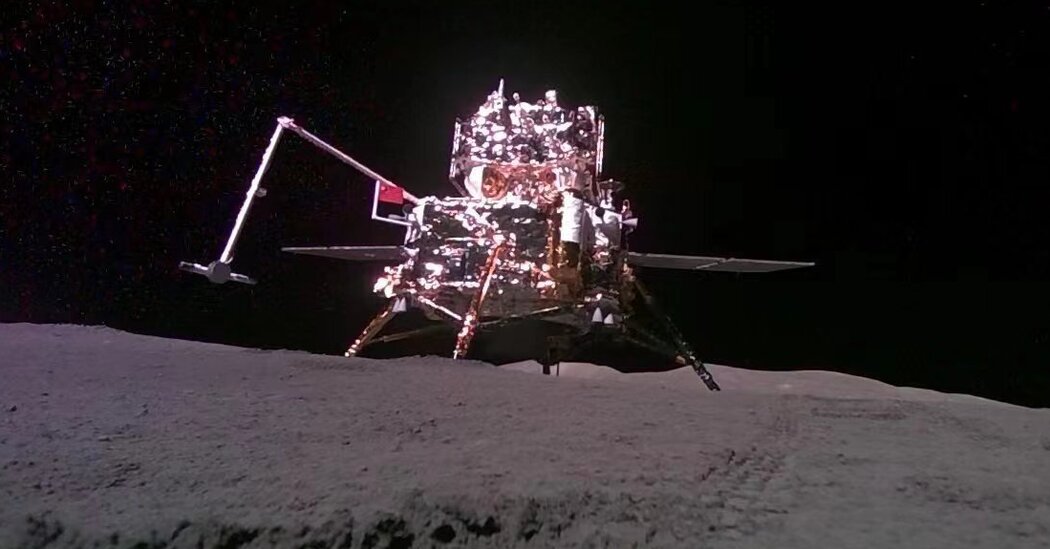The far aspect of the moon – the half that at all times stands away from the bottom – differs mysteriously from the close by aspect. It’s prompted with extra craters and has a bigger crust and fewer Maria or plains the place lava has as soon as fashioned.
Scientists now say that the distinction may be greater than deep pores and skin.
Utilizing a lunar pattern acquired final yr, Chinese language researchers imagine that the insides of the distant aspect of the moon are probably extra dry than its close by. Their discovery, published Within the Nature journal on Wednesday might supply a clearer image of how the pearl ball We admire our night sky It has been fashioned and advanced in billions of years.
The truth that the water content material of the moon far and close by is totally different appears to be “by chance constantly” with variations within the floor traits of the 2 hemispheres of the moon, mentioned Saint -Hu, a researcher on the Chinese language Academy of Sciences in Beijing and writer of the brand new end result. “It is fairly intriguing,” he mentioned.
The moon is considered “bone dry” till the Nineteen Nineties, when scientists started to search out hints of water on its floor. These hints had been confirmed when NASA struck a rocket scene within the Lunar South Pole in 2009.
One of many objectives of this mission and others was to guage the quantity of water deep within the moon, which helps scientists research their previous. The lunar inside is much less modified by the processes that may stand up to the floor.
Again to Earth with Chang’e-6 samples in hand, researchers sought mares or hardened lava grains that broke out from the moon’s mantle. A few of these basalt, as much as 2.8 billion years, contained Olivine, a crystal that fashioned as an historical magma contained in the moon, is cooled, sustaining details about the composition of the mantle at first of the lunar historical past.
The quantity of hydrogen caught within the Olivina allowed scientists to convey out the quantity of water current within the mantle then: between 1 and 1.5 grams of water for each million grams of moon rock.
Earlier sampling measurements collected on the close by moon – from america, the Soviet Union and More recently China – They had been as much as 200 instances extra mock.
The massive distinction within the scope of the water content material obtained from the lunar samples from the close to and much aspect can recommend that the a part of the moon invisible to us on Earth is way more dry, mentioned Dr.
Shuai Li, a planetary geologist on the College of Hawaii in Manoa, who research water on the moon’s floor, described the outcomes as “very fascinating”. However he famous that restricted info might be extracted from one pattern.
“It’s troublesome to say whether or not the distant nation is unquestionably extra dry on the close to nation,” mentioned Dr. Li, who didn’t take part within the work.
One state of affairs steered by the Chang’e-6 group to elucidate the interior variations is that the affect that created the pool on the South Pole-Athan is highly effective sufficient to throw water and different parts on the close by aspect of the moon, exhausting the quantity of water from its far aspect.
One other concept is that the basalts of the Chang’e-6 pattern come from a a lot deeper and drier a part of the moon mantle.
“For me, this is a bit more practical,” says Mahesh Anand, a planetary scientist on the Open College in England who didn’t take part within the research however helped Rate the water content in the lunar interior On the close by nation of China, collected from the Chang’e-5 mission in 2020.
Dr. Anand additionally praised the meticulousness of researchers who’ve chosen a whole bunch of Chang’e-6 pattern, all lower than a sixteenth-size inch to understand the abundance of water.
“The flexibility to do that is sort of diligent and it requires a really advanced and cautious job,” he mentioned.
Extra samples from totally different locations collected from future lunar missions will assist scientists decide whether or not the inside on the far aspect is evenly dry or whether or not it varies within the hemisphere.

